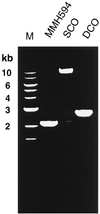Role of Enterococcus faecalis surface protein Esp in the pathogenesis of ascending urinary tract infection
- PMID: 11401975
- PMCID: PMC98508
- DOI: 10.1128/IAI.69.7.4366-4372.2001
Role of Enterococcus faecalis surface protein Esp in the pathogenesis of ascending urinary tract infection
Abstract
Enterococcus faecalis bacteria isolated from patients with bacteremia, endocarditis, and urinary tract infections more frequently express the surface protein Esp than do fecal isolates. To assess the role of Esp in colonization and persistence of E. faecalis in an animal model of ascending urinary tract infection, we compared an Esp(+) strain of E. faecalis to its isogenic Esp-deficient mutant. Groups of CBA/J mice were challenged transurethrally with 10(8) CFU of either the parent or mutant strain, and bacteria in the urine, bladder, and kidneys were enumerated 5 days postinfection. Significantly higher numbers of bacteria were recovered from the bladder and urine of mice challenged with the parent strain than from the bladder and urine of mice challenged with the mutant. Colonization of the kidney, however, was not significantly different between the parent and mutant strains. Histopathological evaluations of kidney and bladder tissue done at 5 days postinfection did not show marked histopathological changes consistent with inflammation, mucosal hyperplasia, or apoptosis, and there was no observable difference between the mice challenged with the parent and those challenged with the mutant. We conclude that, while Esp does not influence histopathological changes associated with acute urinary tract infections, it contributes to colonization and persistence of E. faecalis at this site.
Figures





References
-
- de Chateau M, Bjorck L. Protein PAB, a mosaic albumin-binding bacterial protein representing the first contemporary example of module shuffling. J Biol Chem. 1994;269:12147–12151. - PubMed
-
- Donnenberg M S, Welch R A. Virulence determinants of uropathogenic Escherichia coli. In: Mobley H, Warren J, editors. Urinary tract infections: molecular pathogenesis and clinical management. Washington, D.C.: ASM Press; 1996. pp. 135–174.
-
- Guay G G, Khan S A, Rothstein D M. The tet(K) gene of plasmid pT181 of Staphylococcus aureus encodes an efflux protein that contains 14 transmembrane helices. Plasmid. 1993;30:163–166. - PubMed
-
- Gutierrez J A, Crowley P J, Brown D P, Hillman J D, Youngman P, Bleiweis A S. Insertional mutagenesis and recovery of interrupted genes of Streptococcus mutans by using transposon Tn917: preliminary characterization of mutants displaying acid sensitivity and nutritional requirements. J Bacteriol. 1996;178:4166–4175. - PMC - PubMed
Publication types
MeSH terms
Substances
Grants and funding
LinkOut - more resources
Full Text Sources
Medical
Molecular Biology Databases

